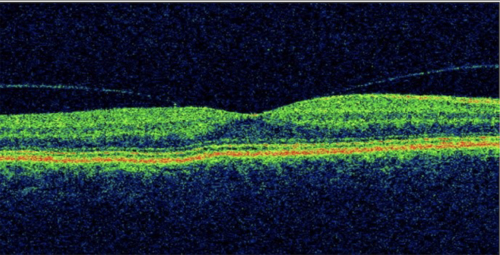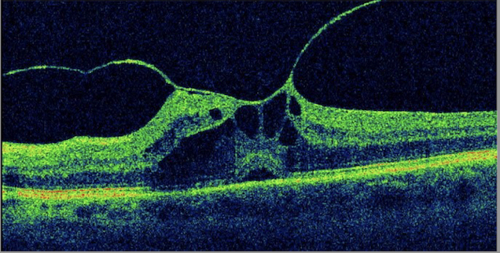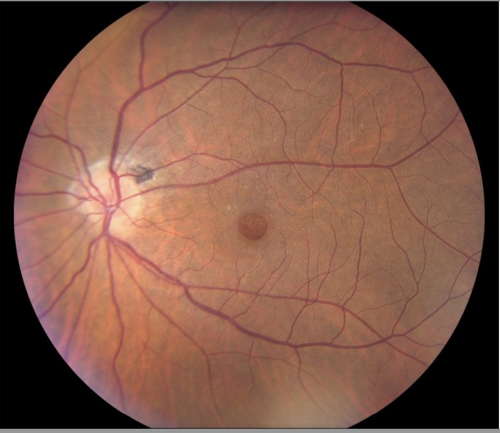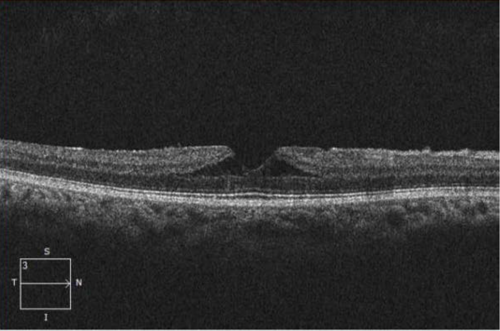Optometrists are instrumental in identifying vitreoretinal traction disorders. Specifically, their ability to do so can play a role in preventing related visual function decline. Optical coherence tomography (OCT) has improved the specificity with which ODs can identify this syndrome. This is because it allows for enhanced imaging of the vitreomacular interface.
Here we present OCT images of vitreoretinal traction syndrome, to demonstrate this technology’s clinical utility.





A call to action
Because vitreoretinal traction syndrome can result in visual function decline and can be associated with other ocular and retinal conditions such as high myopia, age-related macular degeneration, diabetic macular edema, and retinal vein occlusion, it makes sense for the optometrist to keep this syndrome on their radar.12,13 The use of OCT allows for this.
References
- Duker, J. S., Kaiser, P. K., Binder, S., de Smet, M. D., Gaudric, A., Reichel, E., Sadda, S. R., Sebag, J., Spaide, R. F., & Stalmans, P. (2013). The International Vitreomacular Traction Study Group classification of vitreomacular adhesion, traction, and macular hole. Ophthalmology, 120(12), 2611–2619.
- John, V. J., Flynn, H. W., Jr, Smiddy, W. E., Carver, A., Leonard, R., Tabandeh, H., & Boyer, D. S. (2014). Clinical course of vitreomacular adhesion managed by initial observation. Retina, 34(3), 442–446.
- García-Layana, A., García-Arumí, J., Ruiz-Moreno, J. M., Arias-Barquet, L., Cabrera-López, F., & Figueroa, M. S. (2015). A review of current management of vitreomacular traction and macular hole. Journal of ophthalmology, 2015, 809640
- American Academy of Ophthalmology. Idiopathic Macular Hole Preferred Practice Pattern®. 2019. Elsevier Inc.
- Garg, A., Ballios, B. G., & Yan, P. (2021). Spontaneous closure of an idiopathic full-thickness macular hole: A literature review. Journal of vitreoretinal diseases, 6(5), 381–390.
- Morawski, K., Jędrychowska-Jamborska, J., Kubicka-Trząska, A., & Romanowska-Dixon, B. (2016). The analysis of spontaneous closure mechanisms and regeneration of retinal layers of a full-thickness macular hole: Relationship with visual acuity improvement. Retina, 36(11), 2132–2139
- Mansour, A.M., Parodi, M., Uwaydat, S.H,, Charbaji, S., Ascaso, J., Mansour, H.A., Tripathy, K., & Marcelo Barbante Casella, A. (2023). Idiopathic macular hole: Algorithm for nonsurgical closure based on literature review. Journal of ophthalmic & vision research, 18(4), 424–432.
- Michalewska, Z., Michalewski, J., Odrobina, D., & Nawrocki, J. (2012). Non-full-thickness macular holes reassessed with spectral domain optical coherence tomography. Retina, 32(5), 922–929.
- Steel, D. H., & Lotery, A. J. (2013). Idiopathic vitreomacular traction and macular hole: a comprehensive review of pathophysiology, diagnosis, and treatment. Eye, 27 Suppl 1, S1–S21.
- Danielescu, C., Stanca, H. T., & Balta, F. (2020). The management of lamellar macular holes: A Review. Journal of ophthalmology, 2020, 3526316.
- Chehaibou, I., Tadayoni, R., Hubschman, J. P., Bottoni, F., Caputo, G., Chang, S., Dell'Omo, R., Figueroa, M. S., Gaudric, A., Haritoglou, C., Kadonosono, K., Leisser, C., Maier, M., Priglinger, S., Rizzo, S., Schumann, R. G., Sebag, J., Stamenkovic, M., Veckeneer, M., & Steel, D. H. (2024). Natural history and surgical outcomes of lamellar macular holes. Retina, 8(3), 210–222.
- Lin, C. W., Ho, T. C., & Yang, C. M. (2015). The development and evolution of full thickness macular hole in highly myopic eyes. Eye, 29(3), 388–396.
- Wong D. (2011). Is traction the cause or the effect?. Graefe's archive for clinical and experimental ophthalmology, 249(6), 809–810.






